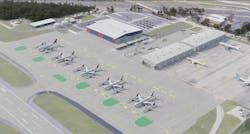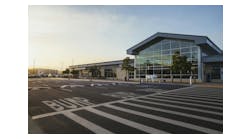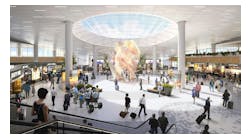Airport Business 2023 Project of the Year: Hartsfield Jackson Atlanta International Airport South Deicing Complex Ramp & Support
The Hartsfield-Jackson Atlanta International Airport (ATL) has expanded its deicing capabilities by constructing a new $147M South Deicing Complex. The Airport was given a goal by the airline stakeholders of zero canceled flights due to a deicing event. To achieve this goal the airport tasked the design team to develop a plan that provides flexibility for simultaneous deicing of five Group V or 10 Group III aircraft.
“Even though it does not snow a whole lot in Atlanta, whenever it does snow and full-on deicing is required, it is always very challenging because we previously did not have enough deicing pads to accommodate the demand,” said Tom Nissalke Hartsfield- Jackson Atlanta International Airport Assistant General Manager/Planning and Development. “This new facility will provide adequate resources for our airline partners to conduct deicing operations, and make sure the national airspace is not impacted when severe weather hits Atlanta.”
The facility had to permit access for aircraft during deicing while simultaneously allowing aircraft to reach the cargo facility for normal operations. Ensuring safe aircraft movement was complicated by an existing taxiway connector that allowed aircraft direct access from the deicing ramp onto Runway 27L. During the design process multiple ramp layout alternatives were considered to address the concerns of the operations team responsible for safely maneuvering aircraft throughout the area during a deicing event. These alternatives were evaluated in a series of safety risk management meetings. The design plans for the South Deicing Complex were solidified in December 2019 and construction began in early 2021. Challenges during the design included trying save as much of the existing pavement (the existing pavement was primarily taxiway pavement that provided access to and from the South Cargo facility) as possible within the project limits. From a grade perspective, the northwest corner of the ramp is about 15 feet higher than the southeast corner.
“One of the things we looked at in design is how could we work those grades—keeping within FAA grade tolerances—to save as much of the existing aprons as possible,” said Dale Stubbs RS&H Vice President. “And it was quite a puzzle.” The resulting design sustained a large percentage of the pavement on the South Cargo apron, while also allowing for continued access during construction, which aided phasing and reduced project cost.
Balram “B” Bheodari, Hartsfield-Jackson Atlanta International Airport General Manager, said the airport is honored to recognized.
“This award is one more validation of the work we’re doing in our capital improvement program,” said Bheodari. “The South Deicing project will continue to ensure ATL maintains and expands its efficiency, even in the face of extreme winter weather.”
Key components for the deicing ramp included:
• Approximately 170,000 square yards of 20” thick airfield concrete pavement
• 6,000 linear feet of trench drain with supporting drainage network
• 487 airfield lights
• Retaining wall
• Jet blast deflector
• 120,000 square feet of pavement markings
To support this deicing ramp the following new facilities were designed and constructed:
• 14,000-square-foot LEED Silver Certified Operations Building with virtual control tower, deicing crew comfort facilities, and two climate-controlled bays for truck maintenance
• Loading racks with five bays for fueling and filling deicing trucks with glycol
• 340,000 gallons of raw deicer product storage with receiving facilities
• A spent deicing facility to manage deicer-impacted stormwater, including diversion structures, a lift station, and two 1.25M gallon pent deicing fluid storage tanks with online monitoring, pH adjustment/odor control and metered sanitary sewer discharge
• First-flush collection system
• Covered parking area for over 50 deicing trucks
• Associated utilities, including 100,000 linear feet of fiber optic backbone for the complex





